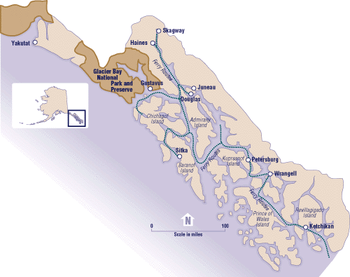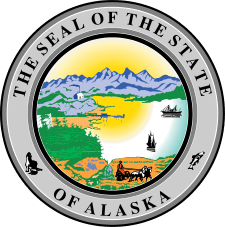Inside Passage

The Inside Passage is a coastal route for oceangoing vessels along a network of passages which weave through the islands on the Pacific coast of North America. The route extends from southeastern Alaska, in the United States, through western British Columbia, in Canada, to northwestern Washington state, in the United States. Ships using the route can avoid some of the bad weather in the open ocean and may visit some of the many isolated communities along the route. The Inside Passage is heavily travelled by cruise ships, freighters, tugs with tows, fishing craft and ships of the Alaska Marine Highway, BC Ferries, and Washington State Ferries systems.
The term "Inside Passage" is also often used to refer to the ocean and islands around the passage itself. The Inside Passage is also sometimes mistakenly referred to as the "Inland Passage" which is in turn a reference to early explorers' quests to locate the Northwest Passage between the Pacific Ocean and the Atlantic Ocean.
Route
It is generally accepted that the Inside Passage starts in Puget Sound in Washington and then extends north, first along the British Columbia Coast and then the Alaska Panhandle.[1][2] In use during the Klondike Gold Rush the passage was one of the sea routes from Seattle and California carrying prospectors north.
British Columbia portion
British Columbia's portion of the route has up to 25,000 miles (40,000 km) of coastline. It includes the narrow, protected Strait of Georgia between Vancouver Island and the B.C. mainland, the Johnstone Strait between Vancouver Island and the mainland, as well as a short stretch along the wider and more exposed Hecate Strait near the Haida Gwaii (formerly the Queen Charlotte Islands). From Fitz Hugh Sound northwards, the route is sheltered via the various large islands in that area such as Princess Royal Island and Pitt Island.
Alaska portion
The Alaskan portion of the Inside Passage extends 500 miles (800 km) from north to south and 100 miles (160 km) from east to west. The area encompasses 1,000 islands, 15,000 miles (24,000 km) of shoreline and thousands of coves and bays. While the Alexander Archipelago in Alaska provides some protection from the Pacific Ocean weather, much of the area experiences strong semi-diurnal tides which can create extreme 30-foot (9 m) differences between high and low tide, so careful piloting is necessary in many places in order to not collide with underwater obstructions.
Adventure Travel Activities
The Inside Passage is a destination for outdoor enthusiasts of all kinds. The coastal mountain ranges and islands make for excellent wildlife viewing and opportunities for outstanding boating, fishing, kayaking, camping and hiking. The communities of Southeast Alaska are excellent launchpads for every level of adventure traveler skill level. Day hikes on local beaches and trails are a favorite with locals and visitors to more extensive and remote camping, kayaking, and hiking experiences. Wildlife viewing in the region ranges from spectacular birding to whale watching and bear viewing. Designated bear viewing is available at Anan Creek near Wrangell and at Pack Creek Bear Sanctuary on Admiralty Island near Juneau.
Cultural references
British author Jonathan Raban described his journey by boat through the Inside Passage from Seattle to Juneau in his 1999 travelogue Passage to Juneau: A Sea and Its Meanings.
Gallery
See also
- British Columbia Coast
- Alaska Panhandle
- List of islands of British Columbia
- BC Ferries
- Alaska Marine Highway
- Washington State Ferries
- MV Queen of the North
References
- ↑ Merriam-Webster, Richard (2000). Merriam-Webster's Collegiate Encyclopedia. Merriam-Webster. p. 808. ISBN 978-0-87779-017-4.
- ↑ Manning, Richard (2001). Inside Passage: A Journey Beyond Borders. Island Press. p. 113. ISBN 978-1-55963-655-1.
External links
| Wikimedia Commons has media related to Inside Passage. |


